Checking the Interior when buying a Bay-window
(68-79) Volkswagen van!
Click any image to enlarge
The interior (assuming its a camper conversion) is the most difficult part of a VW van to describe
as it is a very personnel area so I will not try to cover all the conversions available.
VW never made a camper! Nobody ever believes this. When you discuss camper
vans, everyone describes the Bay Window as a VW Camper! There are a number of companies that converted the Bay Window
into a camper. While VW never produced a camper conversion, they did sanction Westfalia in Germany
to produce a version which could be ordered through the VW dealer network. The "Westy" conversion is considered
to be the best quality of all the conversions available. The quality of the of the material used in a Westy
is very high and this is reflected in the cost of Westy converted vans and the cost of second hand interiors- £500+ for a good condition interior.
If you did not want a "Westy" converted van when new (or second hand) there were a number of companies specializing in converting
Bay Windows into campers. In the UK, the main players were: Devon, Viking, Danbury and Dormobile. These conversions could not be ordered
through VW. The Van had to be bought from VW and then the conversion was arranged with the company by the owner.
As I said earlier, the camping conversion of a van is very subjective to the individual. Before buying, visit shows and see as many conversions
as possible before making up your mind. Different people use there campers for different reasons. While one conversion may be suitable for a weekend
away for 2, it may not be suitable for 2 weeks travelling around Europe.
A camper that has been converted by a specialised company is always going to be of greater value than a home made interior unless
the builder was a skilled joiner. Home built interiors are usually built to suit an individuals needs and may not please other users.
When checking an interior assuming it is a professional conversion look that everything is there. Trying to find lost bits of interior
is very difficult and expensive as they (in most cases) cannot be bought new. Look for signs of wear and tear. Edges damages, wood scratched etc.
The condition will effect the price. Look for signs of damp. Some convertors used chipboard which soaks up water and disintegrates
leaving an un-repairable mess. Most conversions came with a roof conversion which typically hinged away from the roof or is erected by pushing upwards.
Again, another expensive area. Check for signs of damage to the fibreglass and the bellows that form the sides. Roof damage is difficult
to repair and lets in water which causes more problems inside the van.
A large proportion of campers were built by using panel vans and cutting window apertures into the sides. While there is no
problem in this, the glass used may be difficult to obtain if it is broken and seals have to be adapted to fit. You can
tell that a van has been converted because the windows will be flush with the sides of the van. In a van that originally
had windows, such as the micro-bus model, the windows are recessed into the sides by approximately 20mm. Some delivery vans also had
a fixed bulkhead behind the seat which makes for a less versatile camper that the normal "walk-through" versions, where the bulkhead is
split in the middle, so access can be gained to the rear without having to get out the van and open the sliding door. This may
not seem much of a problem when you are viewing a potential purchase but when it blowing a gale and raining cats and dogs, who
would want to get out to enable access to the rear.
I will not try to describe all the different versions on the market, as most altered the specification every couple of years.
Below is a list of the companies with a number of photographs to help you ascertain the conversion company.
Westfalia or "Westy"
The Westy roof has a full length fibreglass roof with either the front or the rear hinged to form a sleeping space approximately 1/2
the length of the van.
The sides of the hinged area when erected, was formed by canvas sides,
which costs around £250 for the canvas alone to replace. When the roof was pushed into place, a cushioned
board is slid into place to form a sleeping surface. Typically the material used in the conversion was light orange.
Individual Interiors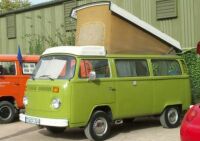
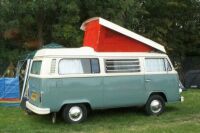
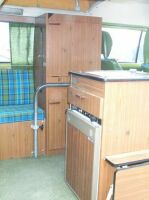
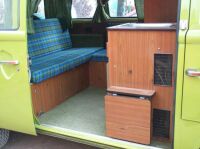




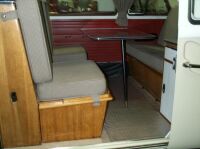
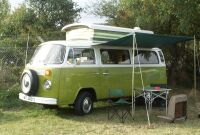
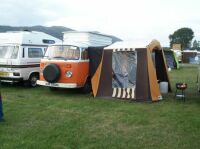
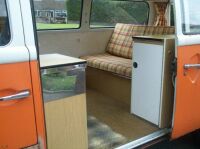
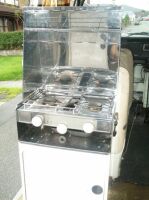
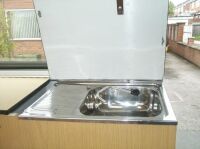
specialise in most aspects of Type 2 interiors
and can supply parts for most interior conversions.